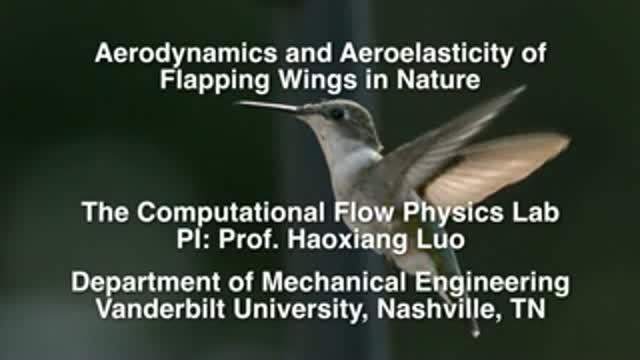The sight of a tiny hummingbird hovering in front of a flower and then darting to another with lightning speed amazes and delights. But it also leaves watchers with a persistent question: How do they do it?
Now, the most detailed, three-dimensional aerodynamic simulation of hummingbird flight conducted to date has definitively demonstrated that the hummingbird achieves its nimble aerobatic abilities through a unique set of aerodynamic forces that are more closely aligned to those found in flying insects than to other birds.
The new supercomputer simulation was produced by a pair of mechanical engineers at Vanderbilt University who teamed up with a biologist at the University of North Carolina at Chapel Hill. It is described in the article "Three-dimensional flow and lift characteristics of a hovering ruby-throated hummingbird" published this fall in the Journal of the Royal Society Interface.
For some time researchers have been aware of the similarities between hummingbird and insect flight, but some experts have supported an alternate model which proposed that hummingbird's wings have aerodynamic properties similar to helicopter blades. However, the new realistic simulation demonstrates that the tiny birds make use of unsteady airflow mechanisms, generating invisible vortices of air that produce the lift they need to hover and flit from flower to flower.
You might think that if the hummingbird simply beats its wings fast enough and hard enough it can push enough air downward to keep its small body afloat. But, according to the simulation, lift production is much trickier than that.
For example, as the bird pulls its wings forward and down, tiny vortices form over the leading and trailing edges and then merge into a single large vortex, forming a low-pressure area that provides lift. In addition, the tiny birds further enhance the amount of lift they produce by pitching up their wings (rotate them along the long axis) as they flap.
Hummingbirds perform another neat aerodynamic trick - one that sets them apart from their larger feathered relatives. They not only generate positive lift on the downstroke, but they also generate lift on the upstroke by inverting their wings. As the leading edge begins moving backwards, the wing beneath it rotates around so the top of the wing becomes the bottom and bottom becomes the top. This allows the wing to form a leading edge vortex as it moves backward generating positive lift.

The most detailed aerodynamic simulation of hummingbird flight conducted to date demonstrates that it achieves its aerobatic abilities through a unique set of aerodynamic forces more closely aligned to those found in flying insects than in other birds. The simulation was produced by Vanderbilt engineers working with a biologist from the University of North Carolina at Chapel Hill.
(Photo Credit: Haoxiang Luo, Vanderbilt University)
According to the simulation, the downstroke produces most of the thrust but that is only because the hummingbird puts more energy into it. The upstroke produces only 30 percent as much lift but it takes only 30 percent as much energy, making the upstroke equally as aerodynamically efficient as the more powerful downstroke.
Large birds, by contrast, generate almost all of their lift on the downstroke. They pull in their wings toward their bodies to reduce the amount of negative lift they produce while flapping upward.
Although hummingbirds are much larger than flying insects and stir up the air more violently as they move, the way that they fly is more closely related to insects than it is to other birds, according to the researchers.
Insects like dragonflies, houseflies and mosquitoes can also hover and dart forward and back and side to side. Although the construction of their wings is much different, consisting of a thin membrane stiffened by a system of veins, they also make use of unsteady airflow mechanisms to generate vortices that produce the lift they need to fly. Their wings are also capable of producing positive lift on both upstroke and downstroke.
To capture the details of the aerodynamics of the hummingbird's ability to hover, Tyson Hedrick, associate professor of biology at UNC, put tiny dabs of non-toxic paint at nine places on a female ruby-throated hummingbird's wing. Then he took high-speed videos at 1,000 frames per second with four cameras while the bird hovered in front of an artificial flower.
Then at Vanderbilt Haoxiang Luo, associate professor of mechanical engineering, and doctoral student Jialei Song took the video, extracted data on the position of the points in three dimensions and reconstructed the varying wing shape and position for a full flapping cycle.
Using the super-computers at the National Science Foundation's Extreme Science and Engineering Discovery Environment (XSEDE) and at Vanderbilt's Advanced Computing Center for Research and Education, the engineers created a fluid-dynamic model that simulated the thousands of tiny vortices that the hummingbird's wings create and so was able to reproduce the complex web of forces that allow these tiny miracles of nature to fly.
Source: Vanderbilt University